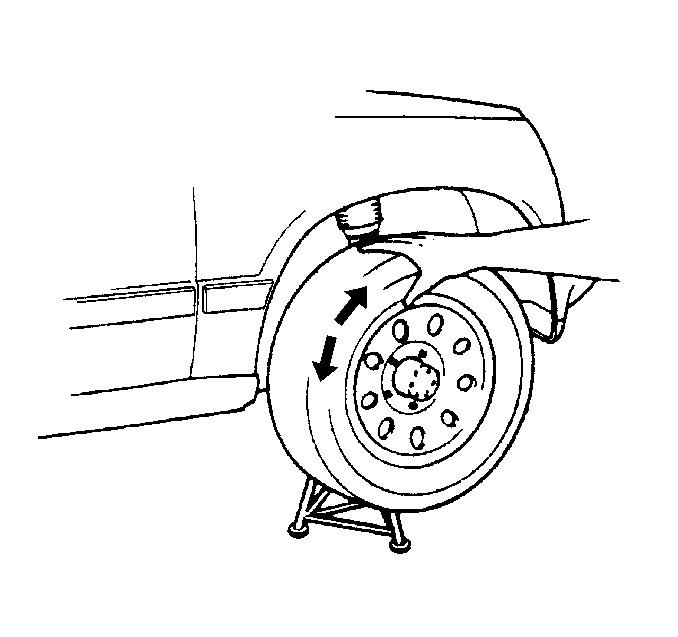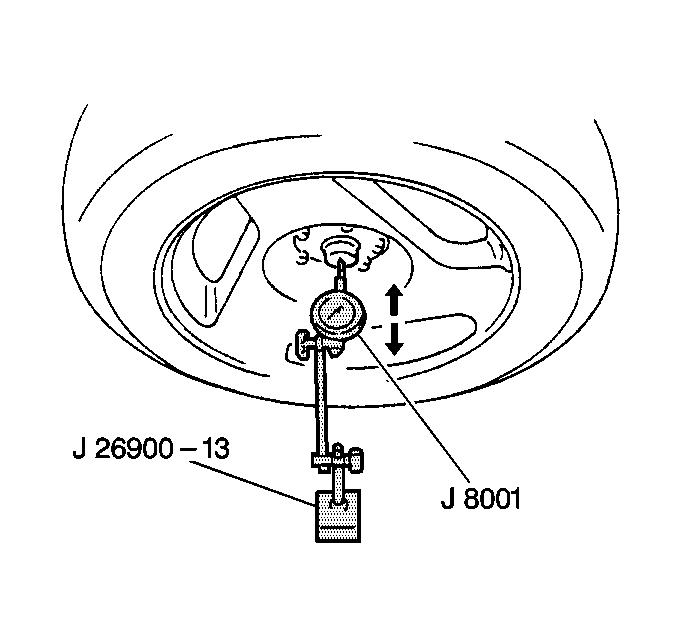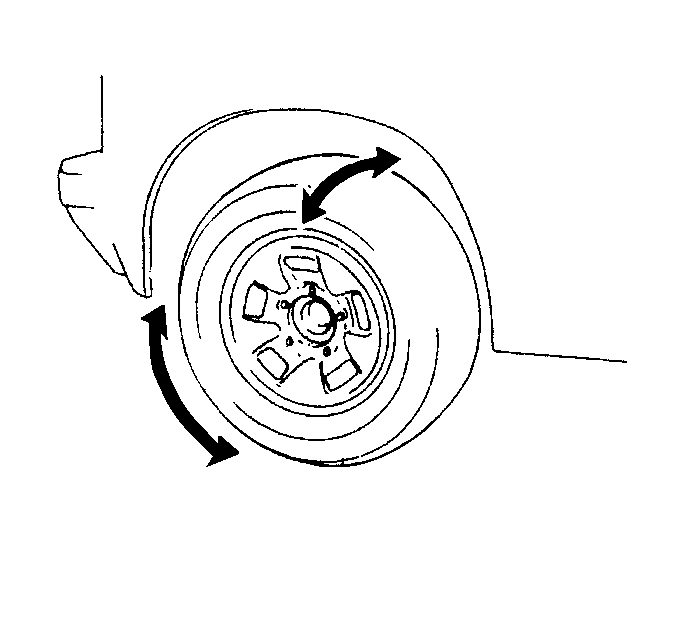For 1990-2009 cars only
Front Wheel Bearings Diagnosis
Complete this procedure in order to measure the looseness of the front wheel bearings. In order to measure the runout of the front wheel bearings, refer to Hub/Axle Flange and Wheel Stud Runout Inspection in Vibration Diagnosis and Correction.
Tools Required
| • | J 8001 Dial Indicator Set |
| • | J 26900-13 Magnetic Indicator Base |
- Partially raise and support the vehicle in order to allow the tire and wheel assembly to rotate freely. Use an alignment rack, if possible. Refer to Lifting and Jacking the Vehicle in General Information.
- Rotate the front tire and wheel assembly. Listen for wheel bearing noise.
- If the wheel bearings emit excessive noise, replace the wheel bearings. Refer to Front Wheel Hub, Bearing, and Seal Replacement in Front Suspension.
- Remove the front tire and wheel assembly. Refer to Tire and Wheel Removal and Installation in Tires and Wheels.
- Remove the plastic hub cover from the wheel.
- Install the front tire and wheel assembly without the plastic hub cover. Refer to Tire and Wheel Removal and Installation in Tires and Wheels.
- Support the front lower control arms with a jack in order to load the lower ball joint.
- Place the J 26900-13 on the floor or on the surface of the alignment rack, if applicable.
- Install the J 8001 to the J 26900-13 .
- Verify that the J 8001 contacts the center of the metal cap.
- Push the tire and wheel assembly inboard.
- Set the J 8001 to 0.
- Pull the tire and wheel assembly outboard in order to measure the wheel bearing looseness. Observe and record the measurement on the J 8001 .
- If the measurement exceeds 0.05 mm (0.002 in), replace the front wheel bearings. Refer to Front Wheel Hub, Bearing, and Seal Replacement in Front Suspension.
- Remove the front tire and wheel assembly. Refer to Tire and Wheel Removal and Installation in Tires and Wheels.
- Install the plastic hub cover on the wheel.
- Install the front tire and wheel assembly. Refer to Tire and Wheel Removal and Installation in Tires and Wheels.
- Lower the vehicle.


Important: Verify that the metal cap is not damaged. If the cap is damaged, replace the cap.
Rear Wheel Bearings Diagnosis
Complete this procedure in order to measure the looseness of the rear wheel bearings. In order to measure the runout of the rear wheel bearings, refer to Hub/Axle Flange and Wheel Stud Runout Inspection in Vibration Diagnosis and Correction.
Tools Required
| • | J 8001 Dial Indicator Set |
| • | J 26900-13 Magnetic Indicator Base |
- Partially raise and support the vehicle in order to allow the tire and wheel assembly to rotate freely. Use an alignment rack, if possible. Refer to Lifting and Jacking the Vehicle in General Information.
- Rotate the rear tire and wheel assembly. Listen for wheel bearing noise.
- If the wheel bearings emit noise, replace the wheel bearings on the rear axle shaft. Refer to Rear Axle Shaft Replacement in Rear Drive Axle.
- Remove the rear tire and wheel assembly. Refer to Tire and Wheel Removal and Installation in Tires and Wheels.
- Remove the plastic hub cover from the wheel.
- Install the rear tire and wheel assembly without the plastic hub cover. Refer to Tire and Wheel Removal and Installation in Tires and Wheels.
- Place the J 26900-13 on the floor or on the surface of the alignment rack, if applicable.
- Install the J 8001 to the J 26900-13 .
- Verify that the J 8001 contacts the center of the hub.
- Push the tire and wheel assembly inboard.
- Set the J 8001 to 0.
- Pull the tire and wheel assembly outboard in order to measure the wheel bearing looseness. Observe and record the measurement on the J 8001 .
- If the measurement exceeds 0.8 mm (0.03 in), replace the wheel bearings on the rear axle shaft. Refer to Rear Axle Shaft Replacement in Rear Drive Axle.
- Remove the rear tire and wheel assembly. Refer to Tire and Wheel Removal and Installation in Tires and Wheels.
- Install the plastic hub cover on the wheel.
- Install the rear tire and wheel assembly. Refer to Tire and Wheel Removal and Installation in Tires and Wheels.
- Lower the vehicle.


